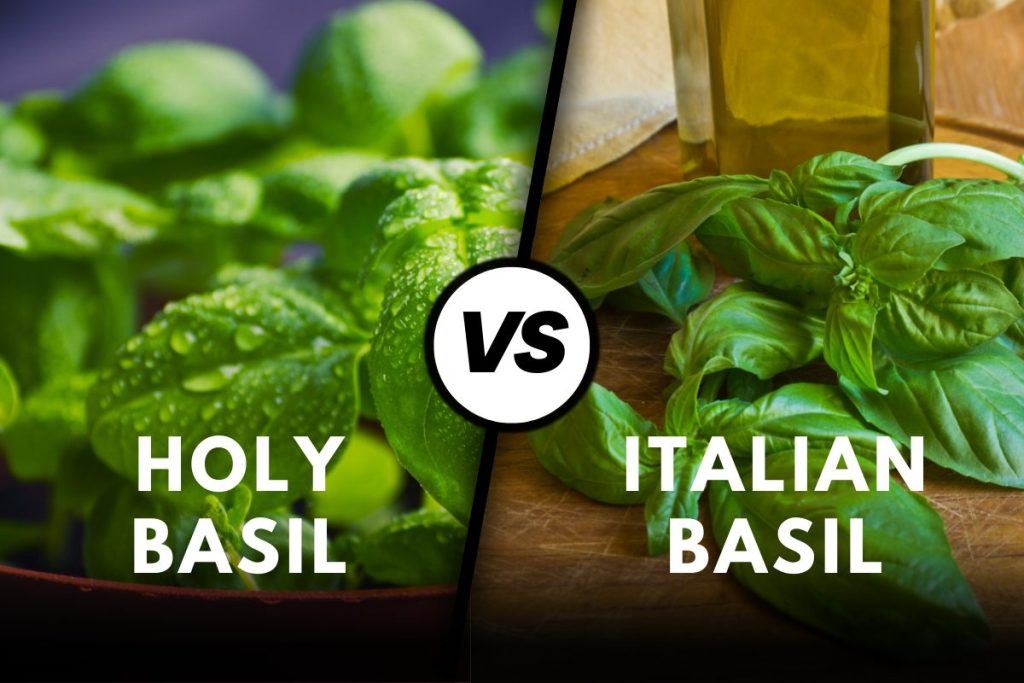Basil is a popular herb that is used in many cuisines around the world. There are many different varieties of basil, each with its own unique flavor and medicinal properties. Two popular varieties are holy basil and Italian basil.
Holy Basil vs Italian Basil
Holy Basil and Italian Basil are two different types of basil. Holy Basil, also known as Tulsi, is an aromatic herb native to India, while Italian Basil is a variety of sweet basil that is widely used in Italian cuisine. Holy Basil has a strong, spicy flavor and is often used in Ayurvedic medicine, while Italian Basil has a mild, sweet flavor and is most commonly used in pesto, sauces, and salads.
In this article, we will compare and contrast these two types of basil, including their flavor profiles, medicinal benefits, and how to use them in cooking.

See Also: Basil vs Cilantro: A Personal Perspective
What is Holy Basil?

Holy basil, also known as Tulsi in Sanskrit, is a type of basil that is native to India and has been used for centuries in Ayurvedic medicine. It is considered to be a sacred plant in Hinduism and is often grown in temples and homes.
Holy basil has a strong, pungent flavor that is slightly sweet and slightly spicy. It is typically used in Indian and Southeast Asian cuisines and is often added to teas, soups, and curries.
What is Italian Basil?

Italian basil is a type of basil that is native to the Mediterranean region. It has a sweet, fragrant aroma and a mild, sweet flavor that is often described as being similar to licorice or anise.
Italian basil is a popular ingredient in Italian and Mediterranean cuisines and is often used to make pesto, salads, and pasta dishes.
Flavor Profile
One of the main differences between holy basil and Italian basil is their flavor profile. Holy basil has a strong, pungent flavor that is slightly sweet and slightly spicy, while Italian basil has a mild, sweet flavor that is similar to licorice or anise.
This difference in flavor makes them suitable for different types of dishes. Holy basil is typically used in savory dishes like soups, curries, and marinades, while Italian basil is used in more delicate dishes like salads, pasta, and pesto.
Health Benefits
Both holy basil and Italian basil have a number of medicinal benefits. Holy basil is known for its anti-inflammatory and antioxidant properties and has been used to treat a variety of ailments including stress, anxiety, and asthma.
It is also believed to have immune-boosting and anti-aging effects. Italian basil, on the other hand, is known for its antimicrobial and anti-inflammatory properties and has been used to treat a variety of conditions including indigestion, nausea, and skin irritation.
How to Use in Cooking?
Holy basil and Italian basil can both be used in a variety of dishes, but they are best suited for different types of recipes.
Holy basil is typically used in savory dishes like soups, curries, and marinades, while Italian basil is used in more delicate dishes like salads, pasta, and pesto.
When using either type of basil in cooking, it is best to add it at the end of the cooking process to preserve its flavor and aroma.
Conclusion
In conclusion, holy basil and Italian basil are two popular types of basil that have their own unique flavor profiles and medicinal benefits.
Holy basil is native to India and has a strong, pungent flavor that is slightly sweet and slightly spicy, while Italian basil is native to the Mediterranean region and has a mild, sweet flavor that is similar to licorice or anise.
Both types of basil can be used in a variety of dishes, but are best suited for different types of recipes. Holy basil is typically used in savory dishes, while Italian basil is used in more delicate dishes.
Overall, both holy basil and Italian basil are valuable ingredients that can add flavor and nutrition to a wide range of dishes.
I am an accomplished tech writer with a passion for simplifying complex technology concepts. With a background in Tech, James has dedicated their career to making the intricacies of the digital world accessible to a broad audience.








